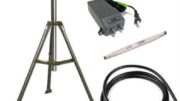Two words: world domination.
In the mid-2000s, satellite TV was experiencing explosive growth. Legislation had taken effect at the turn of the century that let companies like DIRECTV and DISH offer local channels. High-definition television was starting its early tests. And the rise of the DVR meant a lot of interest in television. Keep in mind these were the days before streaming, when TV was king.
DIRECTV wanted more.
Even then, DIRECTV was on its way to becoming the world’s largest satellite television provider. And they weren’t done yet. They wanted more. They wanted more local channels, more sports, more high definition than anyone. And that meant they needed bandwidth.
All that high definition content meant that DIRECTV would prepare to launch the largest communications satellites in history. And they wanted room for tens of thousands of channels. They’d need it in order to blanket the country.
Up until that point, DIRECTV had relied on a patchwork of satellites that were splayed out all over the Western Hemisphere. They wanted to consolidate on three satellite locations that would serve the whole country. So, they made a plan.
Ku wouldn’t cut it
Since the dawn of direct-to-consumer satellite, all broadcasts had used the Ku band. The Ku band, so named because it was slightly below the K band (where broadcasting was unreliable), is a set of frequencies from 12 to 18GHz. It’s ideal for satellite television. So ideal that pretty much every operator wanted to use it. Looking toward the future. DIRECTV management realized that it was going to take a lot more than just Ku band broadcasting to serve the public all the channels they wanted.
DISH, by the way, discovered the same thing at the same time. Their plan was to split their satellite fleet in half, using each to blanket half the country. In that way they could use their Ku-band licenses. Each frequency could be used twice, giving them the capacity they needed.
DIRECTV’s plan was more extreme. The became the sole licensee of all satellite TV spectrum in the Western Hemisphere for the Ka band. The Ka band, sitting at 26.5-40GHz, is that group of frequencies just above the K band. By controlling all broadcast licenses in the Ka band, DIRECTV could guarantee market dominance. The Ka band was wide open territory, suitable for thousands of new channels.
The thing about the Ka band
There are two things that you have to know about the Ka band. Both things aren’t a huge deal, but they’ve shaped the future of marine and mobile satellite television.
The first thing is that the very nature of the Ka band means that any broadcasts done in those frequencies are a little more susceptible to interference from moisture in the air. We call this problem “rain fade” and you’ve probably heard of it. For the most part you deal with this by using more sensitive receiving equipment and larger dishes.
The other thing to know is that most single-satellite systems, like small domes for marine and RV use, can’t read the Ka band. Neither can inexpensive satellite meters. The rest of the world is keyed into the Ku band, and with only DIRECTV using Ka, engineering new equipment could prove costly.
The right decision for most people
DIRECTV’s choice to use Ka-band frequencies let them get more slots in the coveted center of the country. This means better reception for everyone with just one satellite fleet. It’s also meant a virtually limitless landscape full of HD channels, with room for hundreds of 4K channels as well. Rain fade didn’t go away, but today’s dishes are sensitive enough that it’s a mere annoyance.
However, the decision to use Ka-band broadcasts has meant that mobile and marine customers sometimes have to use more expensive technology. Larger domes eliminate rain fade problems, but at some point they are too big for an RV or small craft. This has meant some tough choices have needed to be made for mobile and marine users.
Will DIRECTV change course and move back to the Ku band?
Anything is possible. The world of satellite TV is very different than it was 20 years ago. Instead of satellite being a leading-edge technology, it’s now stable and mature. Television itself competes with streaming and that’s meant fewer new channel launches. The projection of hundreds of 4K channels may never come to pass. Instead, it’s possible that the number of channels may shrink in the coming years. This would open up capacity in the Ku band and open the door for new configurations from DIRECTV.
Do remember though, that there are tens of millions of dishes out there in active use. If there were a major change like that, there would need to be a lot of new dishes, each costing money. At a time when satellite TV isn’t poised for infinite growth, that’s a problem.
I think Ka band is here to stay, but it’s not a bad thing. It’s just something you have to consider. And of course, you can get all the Ka-band equipment you need when you shop at Solid Signal.





